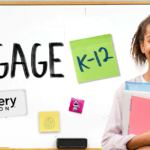By Steve King and Jessica Scheckton
As PR professionals, we spend countless hours honing our messages and perfecting our designs and layout to maximize the chances that our audiences will choose to read our communications. Why wouldn’t we also spend the time to make sure that the estimated one in five Americans who has a disability is, in fact, able to access those same communications in the first place — especially web-based information?
The Realities of Web Use
As Tim Burners-Lee, the inventor of the World Wide Web, said, “The power of the web is in its universality. Access by everyone regardless of disability is an essential aspect.” But the reality is that many of us are simply unaware of the obstacles individuals with disabilities face trying to use our websites, and of the legal obligation school districts have to remove those obstacles.
That’s now changing, thanks in large part to stepped-up enforcement by the U.S. Department of Education’s Office for Civil Rights (OCR). Spurred on by an increase in complaints filed by individuals nationwide, OCR is responding by requiring districts named in the complaints to ensure the ongoing accessibility of their web-based information.
Complying with Federal Rules
So what are the rules governing the accessibility of school district websites? A key regulation is Section 508 of the Rehabilitation Act of 1973. Congress amended it in 1998 to require federal agencies that receive federal funds, including schools, to ensure the accessibility of electronic and information technology, including web-based information. Basically, it established a set of technical standards schools must follow to give people with disabilities access to information that is comparable to that provided to non-disabled users.
However, the Section 508 standards are being revised, and OCR is increasingly seeking schools’ compliance with a more ambitious set of technical standards — the Web Content Accessibility Guidelines (WCAG) 2.0 recommended by the World Wide Web Consortium. Most experts believe the new federal requirements will align with the WCAG.
Then there is also the Americans with Disabilities Act, which requires an “equal playing field” — that is, schools must provide equal access to instruction, curriculum and participation in school-related activities to students regardless of disability.
Three Principals of Accessibility
Essentially, all of these requirements seek to ensure these three principles of web accessibility:
- Perceivable. The information and interface must be available to the senses either through a browser or an assistive device. So, a visually impaired person who cannot see what’s on a webpage must be able to hear the words read aloud by a screen reader. Or a person who is hard-of-hearing must be able to read text captions synched to a video’s audio track.
- Operable. Users with fine motor disabilities must be able to interact with and operate all navigation, controls and interactive elements, either using a mouse, keyboard or assistive device.
- Understandable. Web-based content has to be clear and avoid confusion or ambiguity for a person with cognitive disabilities.
While many aspects of accessibility lie in the hands of web development technicians or website vendors who build or provide the sites schools use, web authors also need to take extra steps when posting all types of content. And like websites themselves, accessibility is never “done.” Every time you add a piece of content or a new feature or interactive element, there are steps to take to make sure you haven’t undermined the accessibility of your site.
‘The Right Thing to Do’
Setting aside legal implications, most school leaders will recognize that making website accessibility a priority is simply the right thing to do, no different from ensuring ramp or elevator access to all floors in a school building. But it is also a fundamental aspect of website usability. These days, mobile responsiveness is a must in website design because we know the public is using smart phones and tablets to access the web, and we want them to be able to access our content on these devices. Should it be any different if their device is a screen reader or other assistive technology?
In fact, think of it the same way you would sidewalk “curb cuts,” originally mandated to help wheelchair users gain access to sidewalks. These have benefited anyone who has ever pushed a baby stroller or pulled a rolling suitcase onto a sidewalk. Making all of your web content accessible to people with disabilities can make visiting your site a better experience for everyone.
A ‘Content Curation Mindset’
Maintaining the accessibility (and usability) of your school website will require you to rethink how you are using your site to share online content with your audience. Abandon the old notion of “If it exists, post it on the site; it doesn’t cost anything!” In fact, there is a cost — the time and resources spent making all of that extra content accessible.
Think of yourself as the site curator, sifting through and carefully choosing content. In other words, develop a “content curation mindset,” with the goal of shrinking your site and evolving it from an endless archive and PDF graveyard into a streamlined, focused online vehicle that reflects how the public seeks out and engages with information today. Your website should be used in concert with the other communication channels at your disposal.
Effective communication is increasingly about more than simply informing; it’s about engagement. Websites are not engagement tools. They’re vehicles designed to deliver passive content. Social media, however, is an engagement tool, where more active content — student stories, photos and videos that people most want to interact with — can have the most impact.
In its early stages, social media was an extension of websites, a place to reach people with content and direct them back to the website for more information. But that’s not how your audience uses social media anymore. They want to like, react, comment, share and retweet. They want to engage with you directly on the social network, without searching for information anywhere else.
Respecting our Audiences’ Desires
Content, no matter how relevant, means nothing if nobody sees it. Our audiences now choose how they get information based on what kind of information they seek, and we should respect that if we want our messages to stand up against the noise of 24/7 communication.
If we do that, if we begin curating web and social content instead of posting everything everywhere, we naturally reduce the workload involved in ensuring that web content is accessible. Remember, we aren’t doing this just for the sake of compliance, but for the sake of usability and effectiveness of all our communications to ensure access for all. And isn’t that what public education and public relations are all about?
Steve King is program manager and Jessica Scheckton is assistant director of communications and public relations for the Capital Region Board of Cooperative Education Services, Albany, N.Y. Contact them at stephen.king@neric.org or jessica.scheckton@neric.org.
The American Consortium for Equity in Education, publisher of the "Equity & Access" journal, celebrates and connects the educators, associations, community partners and industry leaders who are working to solve problems and create a more equitable environment for historically underserved pre K-12 students throughout the United States.
- American Consortium for Equity in Educationhttps://ace-ed.org/author/admin/
- American Consortium for Equity in Educationhttps://ace-ed.org/author/admin/April 23, 2025
- American Consortium for Equity in Educationhttps://ace-ed.org/author/admin/
- American Consortium for Equity in Educationhttps://ace-ed.org/author/admin/







